Why is this Important?
Infants and toddlers are of special concern in a pandemic or any extended emergency because they are particularly vulnerable to illness from unclean water and malnutrition.
Plan to Breastfeed
| From the Department of Health and Human Services website for women and
"When an emergency occurs, breastfeeding saves lives." |

- Breastfeeding protects babies from the risk of a contaminated water supply.
- It provides protection against respiratory illnesses and diarrhea--diseases that can be fatal in populations displaced by disaster.
- The basics of breastfeeding during an emergency are much the same as they are in normal times. Continuing to breastfeed whenever the baby seems hungry maintains a mother's milk supply and provides familiar comfort. The release of hormones while a mother is breastfeeding relieves stress and anxiety and is calming to both mother and baby.
See the La Leche League LLL information on resources on breastfeeding during emergencies, including ways a mother can breastfeed even if she has been feeding her baby formula:
Breastfeeding During Emergencies Additional information on breastfeeding during an emergency can be found at the World Health Organization
Infant Feeding in Emergencies.
You may wish to store several months supply of formula, as well as a few bottles and nipples. These can be used if mother is sick, or dies or in case a friend or loved one has a baby and needs it.
If You Will Use Formula
1. If you will formula feed your infant: Store at least a three month supply. Ready-to-use formula, plus disposable bottles and nipples, are most convenient, but any unused portion must be refrigerated once opened. Powdered formula is more expensive, but you can mix up just the right amount, which avoids waste. However, powdered formula requires an adequate supply of purified water for preparing the formula and cleaning bottles and nipples.
- Preparing formula if water/fuel is scarce:
The Center for Disease Control (CDC) recommends bottled water if using powdered formula. If bottled water is not available, use boiled water. Use chemically treated water to prepare formula only if you do not have bottled or boiled water.
Take Care! If you prepare formula with boiled water, let the formula cool sufficiently before giving it to an infant. Wash your hands before preparing formula and before feeding an infant. You can use alcohol-based hand sanitizer for washing your hands, if the water supply is limited.
- Preparing feeding utensils if water/fuel is scarce:
Clean feeding bottles and nipples with bottled, boiled, or treated water before each use. Consider cup feeding, even for a newborn infant (with proper precautions to avoid choking), as a cup is easier to completely clean and sterilize than a bottle and nipples.
Learn How: See page 41 of this WHO document:
"Infant Feeding In Emergencies",
2. How much powdered formula is a 12 week supply? The amount greatly varies with age and size of the infant. As a general guideli

ne, consider storing per infant:
- At least 12 large cans (25 to 32 oz.) powdered formula
- At least 18 to 24 gallons bottled water (for formula preparation).
Some infants have difficulty digesting one type of formula or another. You may wish to wait to stockpile formula until you have settled on a suitable brand for your infant, before stocking a 3 month supply.
3. If you have no formula: If breastfeeding is impossible, commercially-prepared formula is what pediatricians and nutritionists recommend for infants. However, in an emergency, it is possible that you may run out and be unable to re-supply. If so, you will have to make do with the resources you have on hand.
The following advice, is intended for women in developing countries, and may be adapted for your own use if there are no alternatives:
From the book "Where There Is No Doctor";
The Best Diet for Small Children; pg.120.
<"If a mother's breasts produce little or no milk, she should continue to eat well, drink lots of liquids and let the baby suck her breasts often. After each breast feeding, give the baby, by cup (not bottle), some other type of milk—like boiled cow’s or goat’s milk, canned milk, or powdered milk. (Do not use condensed milk.) Add a little sugar or vegetable oil to any of these milks."
Note: Whatever type of milk is used, some cooled, and boiled water should be added. Here are two examples of correct formulas:
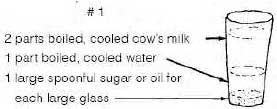
Homemade formula #1
2 parts boiled, cooled cows milk
1 part boiled, cooled water
1 large spoonful sugar or oil
for each large glass | 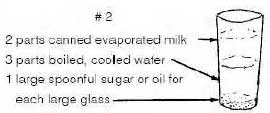
Homemade formula #2
2 parts canned evaporated milk
3 parts boiled, cooled water
1 large spoonful sugar or oil
for each large glass |
|
If non–fat milk is used, add another spoonful of oil.” (1) Copyright Hesperian Foundation. See ‘about this site’ for details.
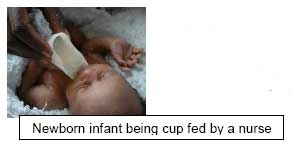
- If possible, boil the milk and water. It is safer to feed the baby with a cup (or cup and spoon) than to use a baby bottle. Baby bottles and nipples are hard to keep clean and can cause infections and diarrhea (see p. 154). If a bottle is used, boil it and the nipple each time before the baby is fed.
If you cannot buy milk for the child, make a porridge from rice, cornmeal, or other cereal. Always add to this some skinned beans, eggs, meat, chicken, or other protein. Mash these well and give them as a liquid. If possible add sugar and oil. WARNING: Cornmeal or rice water alone is not enough for a baby. The child will not grow well. He will get sick easily and may die. The baby needs a main food with added helper foods.”
The Best Diet for Small Children, The First 6 Months of Life Feeding Older Infants and Toddlers
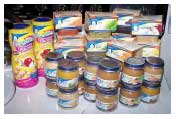
- Many people choose to feed their older infants and toddlers commercial baby foods. For convenience and comfort, you may wish to stock up on a few weeks worth of these foods, if your child is used to and likes them. However, if you haven't done so and are unable to get commercial baby food, you can make your own from foods you may have on hand for older children and adults.
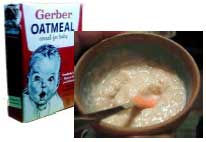
- For infants under one year old, keep giving breast milk or formula, first. Then you can add a thin cooked cereal. Commercially prepared cereals are what most people use, but if you do not have access to these, you can just use regular “adult” grains such as rice, oatmeal or cornmeal cooked with water or milk. Add a little cooking oil for extra calories.
- Little by little, introduce other fruits, vegetables and meat. These need to be cooked, mashed or strained, and mixed with a little breast milk or other milk to make them easier to swallow. Here are three ways to do this:
- Mash your table food thoroughly with a fork. Feed in small amounts.
- Purchase a variety of commercially-prepared baby food jars. These may be labeled as junior food instead of baby food. The advantages are convenience and minimum clean up. The disadvantage is cost.
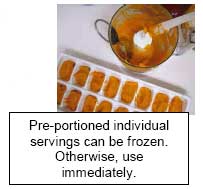
- Make you own “junior food.” Simply take “adult” food and grind it in a food mill. An example product is the KidCo Manual Food Mill, costing less than $15.00 and designed just for this purpose. It is small, manually-operated (non-electric), and easy to clean. The advantage is cost savings. The disadvantage is clean up.
- Feed baby often, at least 5 times a day.
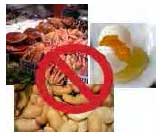
Follow directions in any baby book as to what types of foods to avoid with babies (peanuts and other nuts, shellfish, whole eggs) if at all possible, and be careful baby doesn't choke on foods that are difficult to chew.